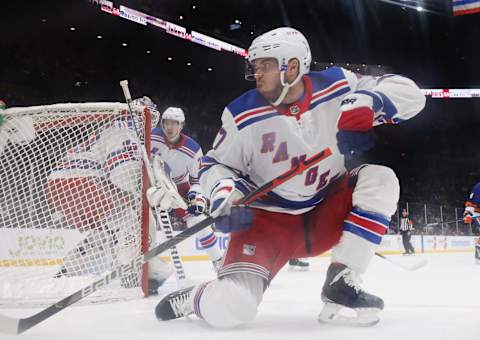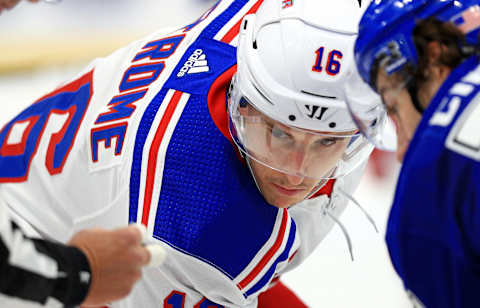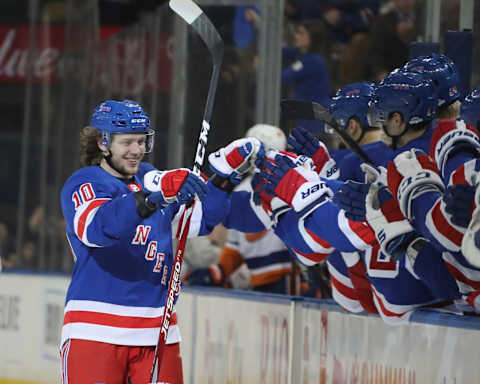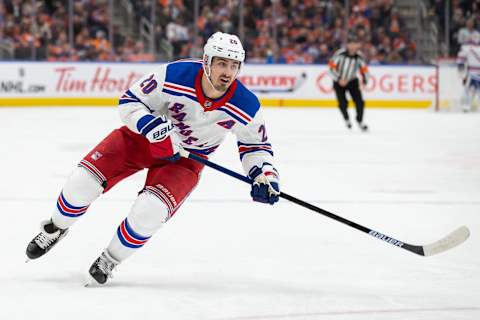New York Rangers: Good news about the salary cap for next season


The NHL announced the guidelines for the 2020-21 season salary cap. How will it affect the New York Rangers after the Chris Kreider contract and the Brady Skjei trade ? It’s mostly good news, but there is work to be done and questions to be answered.
At the GM meetings Wednesday, the NHL announced that the salary cap ceiling will be somewhere between $84 million and $88.2 million next season. The league has to negotiate the number with the NHLPA and the final number should be revealed by June. The $84 million number is with a zero percent inflator. If the full five percent inflator was used, it would be the $88.2 million number.
That’s a minimum increase of $2.5 million with a maximum increase of $6.7 million.
In 2019-20 it was $81.5 million, an increase of $2 million over the prior year and less than what most had projected. The NHLPA triggered a one percent inflator last season to get the cap to $81.5 million.
Here are the annual increases in the salary cap over the last five years.
2019-20: $81.5 million ($2 million increase)
2018-19: $79.5 million ($4.5 million increase)
2017-18: $75 million ($2 million increase)
2016-17: $73 million ($1.6 million increase)
2015-16: $71.4 million ($2.4 million increase)
There had been fears that the increase would be similar to the $2 million increase last season and knowing that is not the case, it’s good news for teams like the Rangers.
Let’s look at the Rangers’ 2020-21 cap situation. To be safe, we will project the increase at the low end, to end up at $84 million though the NHLPA has always triggered some kind of inflator, so it should be higher.
The current roster
The Rangers currently have 15 roster players under contract for next season along with five Restricted Free Agents and two Unrestricted Free Agents (Jesper Fast, Greg McKegg)
Forwards (8):
Artemi Panarin $11,642,857
Chris Kreider $6,500,000
Mika Zibanejad $5,350,000
Pavel Buchnevich $3,250,000
Kaapo Kakko $925,000
Brett Howden $863,333
Filip Chytil $863,333
Julien Gauthier $863,333
Defense (5):
Jacob Trouba $8,000,000
Marc Staal $5,700,000
Brendan Smith $4,350,000
Ryan Lindgren $925,000
Adam Fox $925,000
Goalies (2):
Henrik Lundqvist $8,500,000
Igor Shesterkin $925,000
They also owe buyout payments to three players:
Buyouts (3):
Kevin Shattenkirk $6,083,333
Dan Girardi $1,111,111
Ryan Spooner $300,000
Totals
Those 15 players under contract make $59,613,689.
The three buyouts total $7,494,444.
That means the Rangers have committed $67,108,133
That leaves a range of potential projected cap space from $16,891,867 to $21,091,867.

How to spend $16,891,867 to $21,091,867
The maximum roster size for an NHL team is 24 players. They must dress 20 players for each game. With 15 players under contract, the Blueshirts need to sign a minimum of four forwards and one defenseman to hit the minimum. Knowing the team would like to carry one extra defenseman and one extra forward, that takes the number to five forwards and two defensemen needing to be signed.
The immediate challenge is signing the restricted free agents, all arbitration eligible. Here they are:
RFA’s – all arbitration eligible (current salary in parentheses):
Ryan Strome ($3.1 million)
Brendan Lemieux ($925k)
Tony DeAngelo ($925k)
Phil Di Giuseppe ($700k)
Alexandar Georgiev ($792.5k)
Both Ryan Strome and Tony DeAngelo are having career seasons and will be seeking big paydays. This is especially true for DeAngelo who had a rancorous negotiation with the Rangers as a RFA with no leverage. He ended up holding out at the start of training camp before signing for what the Rangers had originally offered.
Looking at past arbitration award, it’s not unreasonable to expect DeAngelo to get at least $5.5 million, the number that Jacob Trouba was awarded in his 2018 arbitration. Similarly, you can expect Strome to ask for much the same after his season. Let’s assume that Strome signs for $5 million, probably a hometown discount over what he could get elsewhere, but he gets to continue to play with Panarin.
If Strome and DeAngelo sign for $10.5 million that leaves from anywhere from $7 million to $10.5 million left for four more forwards and one defenseman.
The good news for the Rangers is that they can probably expect to sign Lemieux and Di Giuseppe for nominal increases and they can carry Libor Hajek ($833k) as the extra defenseman. Allotting $3 million for those three players, the Rangers should have enough left to re-sign Jesper Fast if he will take $2.5-3 million. Then, they promote Vitali Kravtsov ($925k) to the varsity and they have filled the roster and are still under the cap.
What to do about the goalie situation?
With all of these machinations, we haven’t addressed the goalie situation. There is no way the Blueshirts will go into the next season with three goalies. Igor Shesterkin will definitely be the top goalie and the question is whether the back up will be Alexandar Georgiev or Henrik Lundqvist.
If Lundqvist returns, the Rangers will have to trade Georgiev. If Lundqvist leaves, they will have to re-sign Georgiev. .
There are four options for Lundqvist. 1) He can retire. 2) He can waive his no movement clause and the team could try to trade him. 3) The Rangers can buy him out 4) He can play his final season
If Lundqvist retires, the team gets relief on his entire cap hit. They would have an additional $8.5 million to spend (though they would have to spend some on Georgiev).
If a trade was possible, the Rangers would surely have to retain some salary and salary cap hit. The maximum is 50% so they would save $4.25 million, of which about half would have to go to Georgiev. $2 million seems to be a fair going rate for a backup goaltender.
That would give the Rangers an additional $2.25 million to spend.
The third option is a Lundqvist buyout and that would save the team $3 million next season and cost the team $1.5 million in 2021-22.
If Lundqvist plays the 2020-21 season with the Rangers, it means no cap savings and a trade of Georgiev, ostensibly for prospects or picks as they will have virtually no remaining cap space.

A projected roster for next season
So, with an $84 million salary cap ceiling, here is the theoretical allocation of funds.
Forwards (13): $41,682,856
Artemi Panarin $11,642,857
Chris Kreider $6,500,000
Mika Zibanejad $5,350,000
Pavel Buchnevich $3,250,000
Kaapo Kakko $925,000
Brett Howden $863,333
Filip Chytil $863,333
Julien Gauthier $863,333
Ryan Strome $5,000,000
Jesper Fast $3,000,000
Brendan Lemieux $1,500,000
Phil Di Giuseppe $1,000,000
Vitali Kravtsov $925,000
Defense (7): $26,233,000
Jacob Trouba $8,000,000
Marc Staal $5,700,000
Brendan Smith $4,350,000
Ryan Lindgren $925,000
Adam Fox $925,000
Tony DeAngelo $5,500,000
Libor Hajek $833,000
Goalies (2): $ 2,925,000
Igor Shesterkin $925,000
Alexandar Georgiev $2,000,000
Buyouts (4): $12,994,444
Kevin Shattenkirk $6,083,333
Henrik Lundqvist $5,500,000
Dan Girardi $1,111,111
Ryan Spooner $300,000
The grand total? $ 83,835,300
Key assumptions
In this scenario, there are some key assumptions that have been made.
Lundqvist buyout – This is assuming a buyout, the most expensive proposition when it come to him.
RFA salaries – All of the salaries to be paid out to RFA’s are estimates and are based on the typical salaries for similar players.
UFA salary – The only UFA re-signed would be Jesper Fast. Since they didn’t trade him at the deadline, it’s clear that the team values him. The questions is whether he would leave to get more term or would be be willing to stay on a shorter term deal. At any rate, a $2.5-3 million salary seems fair.
Are the kids ready? – In this lineup, Vitali Kravtsov is a Ranger, as is Julien Gauthier and Phil Di Giuseppe. It includes Libor Hajek on defense, but he could be replaced by Yegor Rykov for much the same money.

Will they be a better team?
So, with the salary cap guidelines set, it appears that the Rangers will be able to retain all of their current players, including pending UFA Jesper Fast. They will have virtually the same hockey team that has turned it around this season and become a playoff factor.
If the goal is playoff contention, they are already there. The question is how much will they improve. It’s true that with one more year under their belt, this young Rangers team will automatically get better.
It’s also true that the team is thin at forward and they need a center who can win a faceoff. While many fans are pinning their hopes on prospect Morgan Barron turning pro and making the team, that’s no sure thing just like the hope that Kravtsov will be NHL ready by next season.
Can Jeff Gorton work some trade magic and deal from his team’s strength in goal and defense for some NHL-ready help at forward? Depending on what happens with Lundqvist there could be enough money to dabble in free agency. The Lundqvist scenario will dictate whether that means signing another Greg Mckegg or having the cap flexibility to find a better player for more money.
The good news is with the Brady Skjei deal and the increase in the cap, the Rangers won’t have to resort to a selloff of talent as they had to last year when they traded away Jimmy Vesey and Vlad Namestnikov. And the other good news is that they will be better next season.
More. Zibanejad honored as NHL's second star. light